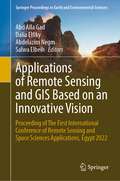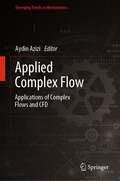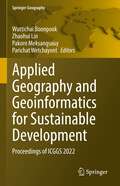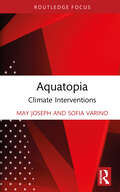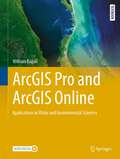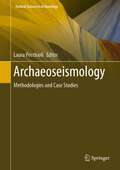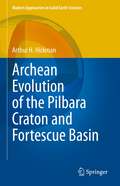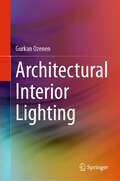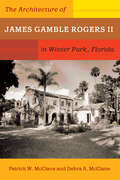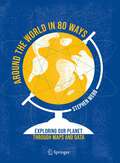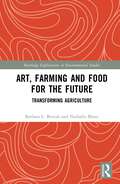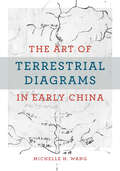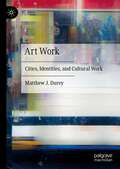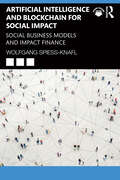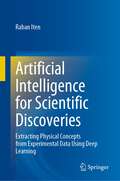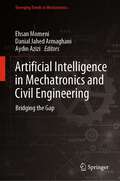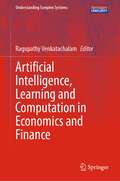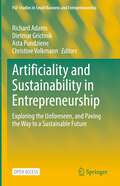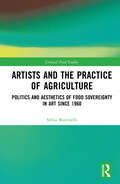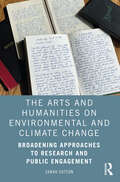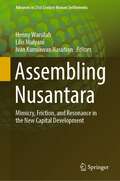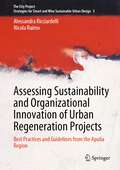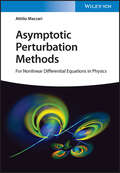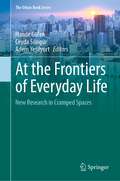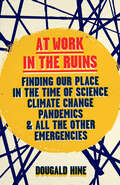- Table View
- List View
Applications of Remote Sensing and GIS Based on an Innovative Vision: Proceeding of The First International Conference of Remote Sensing and Space Sciences Applications, Egypt 2022 (Springer Proceedings in Earth and Environmental Sciences)
by Abd Alla Gad Dalia Elfiky Abdelazim Negm Salwa ElbeihThis book covers various aspects of remote sensing and geographic information systems, from the perspective of earth and environmental sciences. The theme of applications of remote sensing and geographic information systems for the purposes of sustainable development highlights the innovative usage of space imaged spectral data in soil characterization. This book merges the selected contributions to the First International Conference of Remote Sensing and Space Sciences Applications (Egypt 2022) aiming to promote the latest findings on the development of Space Technologies and Applications.
Applied Complex Flow: Applications of Complex Flows and CFD (Emerging Trends in Mechatronics)
by Aydin AziziThis book presents improved numerical techniques and applied computer-aided simulations as a part of emerging trends in mechatronics in all areas related to complex fluids, with particular focus on using a combination of modeling, theory, and simulation to study systems that are complex due to the rheology of fluids (i.e., ceramic pastes, polymer solutions and melts, colloidal suspensions, emulsions, foams, micro-/nanofluids, etc.) and multiphysics phenomena in which the interactions of various effects (thermal, chemical, electric, magnetic, or mechanical) lead to complex dynamics. The areas of applications span materials processing, manufacturing, and biology.
Applied Geography and Geoinformatics for Sustainable Development: Proceedings of ICGGS 2022 (Springer Geography)
by Wuttichai Boonpook Zhaohui Lin Pakorn Meksangsouy Parichat WetchayontThis volume presents the proceedings of the 2nd International Conference of Geography and Geoinformatics for Sustainable Development (ICGGS), held in Phuket, Thailand, April 7-8, 2022. The collection focuses on the importance of spatial thinking and planning by applying geography concepts and geospatial technology innovations in solving global problems such as environmental degradation, urban pollution, and climate change. The proceedings consist of case studies on wide-ranging spatial issues in developing countries, addressing challenges in mainstreaming sustainable development paradigms into their economies to improve natural resource and environmental management. One of the main goals of the volume is to share and exchange different points of view regarding global, regional, and local spatial issues and how to use geography and geoinformatics for building resilience in multiple sectors, e.g., water, ecosystems, agriculture, and health. It offers the opportunity to learn about how geospatial concepts and technologies can contribute to environmental sustainability, while advancing education and research related to geography and geoinformatics. It will be a useful resource for students and researchers to initiate research ideas related to geospatial topics in regional and local scales.
Aquatopia: Climate Interventions (Critical Climate Studies)
by May Joseph Sofia VarinoAquatopia documents Harmattan Theater’s ecological interventions and traces its engagements with water-bound landscapes, colonial histories, climate change, and public space across New York City, Venice, Amsterdam, Lisbon, and Cochin. The volume uses Harmattan’s site-specific performances as a point of departure to consider climate change and rising sea levels as geographical, ecological, and urban phenomena. Instead of a collection of flat, static surfaces, the Aquatopia atlas is animated by a disorienting, anti-mapping strategy, producing a deterritorialized, nomadic, fluid atlas unfolding in real time as an archive of climate change in multidimensional, active space. The book is designed for pedagogical access, with interludes that consolidate the learning outcomes of the experimental theory animating each site-specific performance. Accompanied by close descriptions of five performances and supplemented by digital documentation available online, this volume intervenes in discussions on climate change, urbanism, and postcolonization/decolonialization, and contributes to interdisciplinary studies of ecology and environmental politics, postcolonial/decolonial theories and practices, performance studies and aesthetics, in particular public art, and performance as research.
ArcGIS Pro and ArcGIS Online: Applications in Water and Environmental Sciences (Springer Textbooks in Earth Sciences, Geography and Environment)
by William BajjaliThis textbook serves as a practical guide for undergraduate and graduate students in geology, hydrology, ecology, and environmental sciences, teaching them applied GIS techniques. Presented as a step-by-step tutorial across seventeen chapters, the book starts with the fundamentals of GIS and progresses to real-life examples from geology and water resources. The focus is on ESRI's ArcGIS Pro, covering various tools for spatial, geostatistical, network, and 3-D analysis. Additionally, it explores ArcGIS Online and working with web apps like Web Map, StoryMaps, and GEO App.GIS applications, especially in water and environmental problem-solving, are rapidly growing worldwide. The demand for GIS experts utilizing spatial analysis in environmental science remains high. This textbook equips users with the necessary knowledge to become effective mappers and spatial analysts in the fields of environment, geosciences, and water resources, employing the latest state-of-the-art methodology.Each chapter provides exercises and supplementary materials available for download on SpringerLink, along with additional links for further learning opportunities.
Archaeoseismology: Methodologies and Case Studies (Natural Science in Archaeology)
by Laura PecchioliArchaeoseismic research provides data and information on past earthquakes but is limited by the lack of ongoing discussions about methodology. This volume is an interdisciplinary approach including archaeologists, geologists, geophysicists, seismologists, engineers, and architects from different countries to present a comprehensive recording and interpretation of ancient natural disasters on some case studies. The publication is an introduction to various aspects of the field of archaeoseismology for the knowledge of past seismicity, the reconstruction of the chronological history of a place, the interpretation and identification of seismic effects using different methods, etc. The collection provides an overview of research into archaeoseismology, making new contributions through innovative ideas on various topics. The publication can be an illustrative introduction to better understand the complexity of interpreting seismic effects on ancient and modern masonries, particularly for students with an open mind.
Archean Evolution of the Pilbara Craton and Fortescue Basin (Modern Approaches in Solid Earth Sciences #24)
by Arthur H. HickmanOne of today’s major geoscientific controversies centres on the origin of the Archean granite‒greenstone terranes. Is the geology of these scattered remnants of our planet’s early crust consistent with the theory that modern-style plate-tectonic processes operated from the early Archean, or does it indicate that tectonic and magmatic processes were different in the Archean? Earth has clearly evolved since its initial formation, so at what stage did its processes of crustal growth first resemble those of today? The logical place to seek answers to these intriguing and important questions is within the best-preserved early Archean crust. The Pilbara region of northwest Australia is internationally famous for its abundant and exceptionally well-preserved fossil evidence of early life. However, until recently the area has received much less recognition for the key evidence it provides on early Archean crustal evolution. This book presents and interprets this evidence through a new stage-by-stage account of the development of the Pilbara’s geological record between 3.53 and 2.63 Ga. The Archean Pilbara crust represents one fragment of Earth’s oldest known supercontinent Vaalbara, which also included the Kaapvaal Craton of southern Africa. Recognition of Vaalbara expands the background database for both these areas, allowing us to more fully understand each of them.
Architectural Interior Lighting
by Gurkan OzenenArchitectural Interior Lighting is an essential guide to creating well-lit, visually appealing interior spaces. The book begins with an overview of light and color theory, lighting fundamentals, and design principles. It then covers artificial, natural, decorative, and professional lighting in interior design, as well as standards and regulations, controls and systems, sustainable lighting, energy efficiency, light pollution reduction, and the use of environmentally friendly materials. With a focus on practical applications and real-world examples, this book provides readers with the tools and knowledge necessary to achieve their design goals while considering the latest trends and techniques in the field. A valuable resource for professionals and students in architecture and lighting design, it will also appeal to anyone interested in creating visually stunning and functional interior spaces.
The Architecture of James Gamble Rogers II in Winter Park, Florida
by Patrick W. McClane Debra A. McClaneExploring the life and career of one of Florida's premier architectsThis well-illustrated book illuminates the life and career of one of Florida's premier architects, whose elegant homes and design aesthetic shaped the architectural character of Winter Park and influenced urban development throughout central Florida.James Gamble Rogers II (1901-1990) created homes known for their human scale and proportion and for their suitability to the environment. This work highlights twelve of these residences designed for Winter Park, the beautiful small city adjacent to Orlando and the headquarters of the Rogers family architecture firm, Rogers, Lovelock, and Fritz, which exists today under the leadership of Rogers' son. Ingeniously meeting the special needs of Florida's climate—heat, humidity, termite control, and air circulation--the residences incorporate details from a variety of historical styles, including eccletic and authentic features that emulate vernacular Spanish farmhouses and villas.The book includes critiques of each design and its evolution, particulars about the site, and stories about the lives and tastes of the clients—men and women of wealth and status who influenced the heady era of the Florida land boom in the 1920s and 1930s. Numerous floor plans, modern and historical photographs, and Rogers' own drawings augment the discussion.The book also presents an entertaining biography of Rogers, with information on his schooling, a history of the firm he founded, and his familial connections with the architectural profession (his uncle and namesake designed more than 20 buildings for Yale University). It describes his success in the areas of governmental, military, and university architecture, including his designs for buildings at Rollins College in Winter Park, and evaluates his impact on 20th-century architecture in Florida and throughout the nation.Coauthors Patrick and Debra McClane have studied Rogers' original drawings, toured his homes, and interviewed clients and family members; Patrick McClane worked at the Rogers firm during the architect's last years there and brings a personal connection to this work. Their book documents an exceptional contribution to Florida's architectural heritage, the life and work of a man who created stylish and desirable homes and distinctive public buildings.With a detailed appendix that lists dates and addresses for nearly 275 houses, most of them still extant, the work will serve as the definitive guide to Rogers' work in Winter Park.
Around the World in 80 Ways: Exploring Our Planet Through Maps and Data
by Stephen WebbAround the World in 80 Ways offers a (sometimes opinionated) discussion of 80 data-driven maps of our planet. Taken together, the maps tell a story about the physical world; about the impact our species is having on the world; and about how people live in the world – or at least how we lived immediately before the emergence of Covid-19. The maps lie. All maps lie. But the origins of the deceptions are explained, the data sources are signposted and referenced, and the readers are shown how to create their own maps using freely available software. The reader is thus armed with the tools needed to explore local, national or world data – on topics ranging from science to society; environment to entertainment; wealth to wellbeing – a valuable skill in an age when certain politicians are happy to refer to “alternative facts” and media outlets deliver data visualizations that sometimes mislead as much as inform.
Art, Farming and Food for the Future: Transforming Agriculture (Routledge Explorations in Environmental Studies)
by Barbara L. Benish Nathalie BlancThis book explores the impact of artistic experiments in inspiring people to turn away from current food consumerism and take an active role in preserving, sustaining, and protecting the environment. As artists are expanding their practice into social justice and community concerns, erasing traditional forms of expression and integrating others, the culture around food and its production has been added to a new vocabulary of experiential art. The authors measure the impact of such experiments on local food consumption and production, focusing on education and youth, both in the surrounding community and culture at large. They suggest how these projects can be up-scaled to further encourage sustainable solutions for our environment and communities. The book explores the reflections and motivations of case study practitioners in urban and rural areas and, through interviews, engages with artists who are pioneering a new trend to create hubs of activity away from traditional art spaces in cities to follow a non-hierarchal practice that is de-centralized and communally based. This book will be of great interest to academic readers concerned with issues related to environmental aesthetics, eco-design, eco-criticism, culture, heritage, memory, and identity, and those interested in the current debates on the place of aesthetics and culture in sustainability.
The Art of Terrestrial Diagrams in Early China
by Michelle H. WangA study of early Chinese maps using interdisciplinary methods. This is the first English-language monograph on the early history of maps in China, centering on those found in three tombs that date from the fourth to the second century BCE and constitute the entire known corpus of early Chinese maps (ditu). More than a millennium separates them from the next available map in the early twelfth century CE. Unlike extant studies that draw heavily from the history of cartography, this book offers an alternative perspective by mobilizing methods from art history, archaeology, material culture, religion, and philosophy. It examines the diversity of forms and functions in early Chinese ditu to argue that these pictures did not simply represent natural topography and built environments, but rather made and remade worlds for the living and the dead. Wang explores the multifaceted and multifunctional diagrammatic tradition of rendering space in early China.
Art Work: Cities, Identities, and Cultural Work
by Matthew J. DureyThis book is about the relationship between art and work in the cultural economy. It is an exploration of the experiences of people working in cultural and creative industries, and of the importance of place, identity, and culture in postindustrial society. Drawing on fieldwork exploring the conditions of cultural work, identity, and postindustrial cities in Newcastle upon Tyne, UK and Hamburg, Germany, the book argues that the conditions of work in the cultural economy are the result of a contradictory tension between art and economy, which manifests in various ways in artists’ conditions of work, their identities, and their relationship to the changing landscapes of postindustrial cities. This is explored through a series of stories from people working in cultural and creative industries, in which they highlight significant contradictions, obstacles, and opportunities in negotiating the cultural economy, casting light on the importance of art and culture in postindustrial society.
Artificial Intelligence and Blockchain for Social Impact: Social Business Models and Impact Finance
by Wolfgang Spiess-KnaflArtificial Intelligence and Blockchain for Social Impact provides an accessible overview of artificial intelligence (AI) and blockchain technologies, and explores their applications for social enterprise and impact investing. The opening chapter introduces the impact space, exploring different social business models, the role of technology, the impact investing market and general problems in the space. The remainder of this book falls into two paths: the first focusing on AI and the other looking at the blockchain technology. Providing introductions to each of these technologies and their histories, the author goes on to examine them from the perspectives of social business models and impact finance. A concluding chapter explores AI and cryptocurrencies in the impact space in the future. Readers are supported with international case studies and other student-friendly features. Situated at the intersection between technology, fintech, social enterprise, impact investing and social impact, this book is a valuable resource for upper-level courses across all these areas. It also offers an introduction to this emerging topic for researchers and business professionals. Online teaching resources to accompany this book include instructor lecture slides and data sets.
Artificial Intelligence for Scientific Discoveries: Extracting Physical Concepts from Experimental Data Using Deep Learning
by Raban ItenWill research soon be done by artificial intelligence, thereby making human researchers superfluous? This book explains modern approaches to discovering physical concepts with machine learning and elucidates their strengths and limitations. The automation of the creation of experimental setups and physical models, as well as model testing are discussed. The focus of the book is the automation of an important step of the model creation, namely finding a minimal number of natural parameters that contain sufficient information to make predictions about the considered system. The basic idea of this approach is to employ a deep learning architecture, SciNet, to model a simplified version of a physicist's reasoning process. SciNet finds the relevant physical parameters, like the mass of a particle, from experimental data and makes predictions based on the parameters found. The author demonstrates how to extract conceptual information from such parameters, e.g., Copernicus' conclusion that the solar system is heliocentric.
Artificial Intelligence in Mechatronics and Civil Engineering: Bridging the Gap (Emerging Trends in Mechatronics)
by Ehsan Momeni Danial Jahed Armaghani Aydin AziziRecent studies highlight the application of artificial intelligence, machine learning, and simulation techniques in engineering. This book covers the successful implementation of different intelligent techniques in various areas of engineering focusing on common areas between mechatronics and civil engineering. The power of artificial intelligence and machine learning techniques in solving some examples of real-life problems in engineering is highlighted in this book. The implementation process to design the optimum intelligent models is discussed in this book.
Artificial Intelligence, Learning and Computation in Economics and Finance (Understanding Complex Systems)
by Ragupathy VenkatachalamThis book presents frontier research on the use of computational methods to model complex interactions in economics and finance. Artificial Intelligence, Machine Learning and simulations offer effective means of analyzing and learning from large as well as new types of data. These computational tools have permeated various subfields of economics, finance, and also across different schools of economic thought. Through 16 chapters written by pioneers in economics, finance, computer science, psychology, complexity and statistics/econometrics, the book introduces their original research and presents the findings they have yielded.Theoretical and empirical studies featured in this book draw on a variety of approaches such as agent-based modeling, numerical simulations, computable economics, as well as employing tools from artificial intelligence and machine learning algorithms. The use of computational approaches to perform counterfactual thought experiments are also introduced, which help transcend the limits posed by traditional mathematical and statistical tools.The book also includes discussions on methodology, epistemology, history and issues concerning prediction, validation, and inference, all of which have become pertinent with the increasing use of computational approaches in economic analysis.
Artificiality and Sustainability in Entrepreneurship: Exploring the Unforeseen, and Paving the Way to a Sustainable Future (FGF Studies in Small Business and Entrepreneurship)
by Richard Adams Dietmar Grichnik Asta Pundziene Christine VolkmannThis open access edited volume explores the past, present, and future of artificiality and sustainability in entrepreneurship – the unforeseen consequences and ways to advance to a sustainable future. In particular, it connects artificiality, sustainability and entrepreneurship, intertwining artificial with the specific phenomenon of those novel digital technologies that provoke continuous and significant change in our lives and business. Unlike digital entrepreneurship research, which focuses on digital technology development and management, this book covers processes and mechanisms of sustainable adaptability of entrepreneurs, the business logic of start-ups, and the collaborative behaviours under the mass digital transformation, including the prevalence of artificial intelligence. Some of the questions that this book answers are as follows: How has entrepreneurship reacted to such challenges previously? What lessons have been learned and need to be carried forward? How can entrepreneurship and the artefacts of entrepreneurship respond to current challenges? What should be the mindset of the entrepreneur to assure sustainable adaptation? How to embrace and embed the new business logic?
Artists and the Practice of Agriculture: Politics and Aesthetics of Food Sovereignty in Art since 1960 (Critical Food Studies)
by Silvia BottinelliArtists and the Practice of Agriculture maps out examples of artistic practices that engage with the aesthetics and politics of gathering food, growing edible and medicinal plants, and interacting with non-human collaborators. In the hands of contemporary artists, farming and foraging become forms of visual and material language that convey personal and political meanings. This book provides a critical analysis of artistic practices that model alternative food systems. It presents rich academic insights as well as 16 conversations with practicing artists. The volume addresses pressing issues, such as the interconnectedness of human and other-than-human beings, the weight of industrial agriculture, the legacy of colonialism, and the promise of place-based and embodied pedagogies. Through participatory projects, the artists discussed here reflect on the links between past histories, present challenges, and future solutions for the food sovereignty of local and networked communities. The book is an easy-to-navigate resource for readers interested in food studies, visual and material cultures, contemporary art, ecocriticism, and the environmental humanities.
The Arts and Humanities on Environmental and Climate Change: Broadening Approaches to Research and Public Engagement
by Sarah SuttonThe Arts and Humanities on Environmental and Climate Change examines how cultural institutions and their collections can support a goal shared with the scientific community: creating a climate-literate public that engages with environmental issues and climate change in an informed way. When researchers, curators, and educators use the arts and humanities to frame discussions about environmental and climate change, they can engage a far wider public in learning, conversation, and action than science can alone. Demonstrating that archival and object-based resources can act as vital evidence for change, Sutton shows how the historical record, paired with contemporary reality, can create more personal connections to what many consider a remote experience: the changing climate. Providing valuable examples of museum collections used in discussions of environmental and climate change, the book shares how historic images and landscape paintings demonstrate change over time; and how documentary evidence in the form of archaeological reports, ships logs, Henry David Thoreau’s journals, and local reports of pond hockey conditions are being used to render climate data more accessible. Images, personal records, and professional documents have critical roles as boundary objects and proxy data. These climate resources, Sutton argues, are valuable because they make climate change personal and attract a public less interested in a scientific approach. This approach is underused by museums and their research allies for public engagement and for building institutional relevancy. The Arts and Humanities on Environmental and Climate Change will be most interesting to readers looking for ways to broaden engagement with environmental and climate issues. The ideas shared here should also act as inspiration for a broad spectrum of practitioners, particularly those writing, designing, and curating public engagement materials in museums, for wider research, and for the media.
Assembling Nusantara: Mimicry, Friction, and Resonance in the New Capital Development (Advances in 21st Century Human Settlements)
by Lilis Mulyani Henny Warsilah Ivan Kurniawan NasutionToday, the new Indonesian capital city, Nusantara, planning is being anticipated as “representing national identity,” “a model city,” or “a gift to the world,” and many other extraordinary labels. This book examines the reality of an ongoing developmental transformation of the Nusantara beyond those labels. It approaches its assemblage of humans, their works (plans, documents, policies, and others), non-human objects (biodiversity, landscape, geography, physical infrastructure, buildings, and public spaces), processes, social relationships, social infrastructures, and others. It is organized into three themes—mimicry, friction, and resonance. The mimicry illustrates the similarities (and differences) between Nusantara and other capital cities in urban narratives, imageries, and forms. The friction studies how Nusantara moves actors who do not always agree, processes that do not always align or collaboration between diverse contradicting groups that intersect. The resonance observes how Nusantara resonates with, yet communicates its voice toward, the world. The three concepts (originated from geography, anthropology, and sociology) frame the analytics of the various contributions of local and foreign scientists from multiple disciplines. Overall, the book recommends “Otorita Ibu Kota Nusantara” (Nusantara capital city authority) on the current experimentation and implementation of the urban vision and provides a reference for social scientists to study Nusantara. And more broadly, the book offers the current socio-spatial practices of capital city-making in Asia that are valuable for the region.
Assessing Sustainability and Organizational Innovation of Urban Regeneration Projects: Best Practices and Guidelines from the Apulia Region (The City Project #3)
by Alessandra Ricciardelli Nicola RaimoThis book offers the first comprehensive report on the topic of organizational innovation and sustainability of urban regeneration from the public manager's perspective. Starting from a rich set of case studies on urban regeneration from the region of Apulia, in Italy, it develops a framework for measuring their sustainability performance. It proposes the use of indicators related to different aspects of the urban regeneration process, including the participations of stakeholders; land use and buildings; economy and jobs; transportation; environmental pollution; energy use; waste management; as well as open spaces and wildlife. This book offers extensive information to graduate students and researchers, and to authorities, developers, investors and stakeholders alike, involved in the design, planning and management, and sustainable development of urban spaces. It is expected to foster a better understanding of the level of organizational innovation and sustainability of urban regeneration projects and the role of governing bodies in their implementation.
Asymptotic Perturbation Methods: For Nonlinear Differential Equations in Physics
by Attilio MaccariAsymptotic Perturbation Methods Cohesive overview of powerful mathematical methods to solve differential equations in physics Asymptotic Perturbation Methods for Nonlinear Differential Equations in Physics addresses nonlinearity in various fields of physics from the vantage point of its mathematical description in the form of nonlinear partial differential equations and presents a unified view on nonlinear systems in physics by providing a common framework to obtain approximate solutions to the respective nonlinear partial differential equations based on the asymptotic perturbation method. Aside from its complete coverage of a complicated topic, a noteworthy feature of the book is the emphasis on applications. There are several examples included throughout the text, and, crucially, the scientific background is explained at an elementary level and closely integrated with the mathematical theory to enable seamless reader comprehension. To fully understand the concepts within this book, the prerequisites are multivariable calculus and introductory physics. Written by a highly qualified author with significant accomplishments in the field, Asymptotic Perturbation Methods for Nonlinear Differential Equations in Physics covers sample topics such as: Application of the various flavors of the asymptotic perturbation method, such as the Maccari method to the governing equations of nonlinear system Nonlinear oscillators, limit cycles, and their bifurcations, iterated nonlinear maps, continuous systems, and nonlinear partial differential equations (NPDEs) Nonlinear systems, such as the van der Pol oscillator, with advanced coverage of plasma physics, quantum mechanics, elementary particle physics, cosmology, and chaotic systems Infinite-period bifurcation in the nonlinear Schrodinger equation and fractal and chaotic solutions in NPDEs Asymptotic Perturbation Methods for Nonlinear Differential Equations in Physics is ideal for an introductory course at the senior or first year graduate level. It is also a highly valuable reference for any professional scientist who does not possess deep knowledge about nonlinear physics.
At the Frontiers of Everyday Life: New Research in Cramped Spaces (The Urban Book Series)
by Hande Gülen Ceyda Sungur Adem YeşilyurtThe book provides a critical analysis of the geographies of everyday life, looking at how spatial practices craft w(r)iggle room to cope with the boundaries saturated by normativity, power relations, and inequalities. It explores the possibilities for making do with the everyday practices forming a way of living in cramped spaces. In this respect, early-career researchers and activists share their fieldwork experiences through an intersectional lens based on emerging research methodologies and scholar-activist practices. From their own vantage point, they look at their own contexts, practices, and research subjects at the level of everyday life.Spatial practices and place-based imaginaries from France, Finland, and Spain to Turkey and South Africa present a wide range of non-counter hegemonic yet enabling practices for transformation in everyday life. The contributors, trained in a variety of convergent disciplines concerned with everyday life and space (geography, geopolitics, architecture, urban planning, sociology, political sciences), discuss scholar-activist methodologies during the current crisis in contemporary academia, reflect on their research methodologies and research experiences, and inquire into the ways of embodied negotiations for agency, survival, and care.A group of early-career researchers and activists came together to seek out the possibilities of transformative change in everyday life during the peak periods of COVID-19. When researchers and activists were forced to stay at home in isolation, the authors met up online to discuss their subjectivities self-reflexively to challenge the distance between the researcher and “the field.” The book is the outcome of their collective production based on numerous meetings, writing workshops, and creative debates.
At Work in the Ruins: Finding Our Place in the Time of Science, Climate Change, Pandemics and All the Other Emergencies
by Dougald Hine'One of the most perceptive and thought-provoking books yet written about the multiple intersecting crises that are now upending our once-familiar world. . . Essential reading for these turbulent times.' Amitav Ghosh, author of The Great Derangement 'Hine’s brilliant book demands we stare into that abyss and rethink our securest certainties about what is actually going on in the climate crisis. It’s lucidly unsettling and yet in the end empowering. There is something we can do, and it starts with where we look, how we see and what we choose to change.’ Brian Eno, Musician Dougald Hine, author and social thinker, has spent most of his life talking to people about climate change. And then one afternoon in the second year of the pandemic, he found he had nothing left to say. Why would someone who cares so deeply about ecological destruction want to stop talking about climate change now? At Work in the Ruins explores that question. “Climate change asks us questions that climate science cannot answer,” Hine says. Questions like, how did we end up in this mess? Is it just a piece of bad luck with the atmospheric chemistry—or is it the result of a way of approaching the world that would always have brought us to such a pass? How we answer such questions has consequences. According to Hine, our answers shape our understanding and our thinking about what kind of problem we think we’re dealing with and, therefore, what kind of responses we go looking for. “But when science is turned into an object of belief and a source of overriding authority,” Hine continues, “it becomes hard even to talk about the questions that it cannot answer.” In eloquent, deeply researched prose, Hine demonstrates how our over-reliance on the single lens of science has blinded us to the nature of the crises around and ahead of us, leading to ‘solutions’ that can only make things worse. At Work in the Ruins is his reckoning with the strange years we have been living through and our long history of asking too much of science. It’s also about how we find our bearings and what kind of tasks are worth giving our lives to, given all we know or have good grounds to fear about the trouble the world is in. For anyone who has found themselves needing to make sense of the COVID time and how we talk about it, At Work in the Ruins offers guidance by standing firmly forward and facing the depth of the trouble we are in. Hine, ultimately, helps us find the work that is worth doing, even in the ruins. 'A book of rare originality and depth—profound, far-reaching, mind-altering stuff.' Helen Jukes, author of A Honeybee Heart has Five Openings
